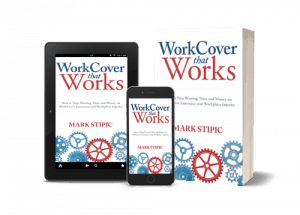 Many consultants publish books on the understanding that a published work provides legitimacy and authority to their advice. Sometimes these books are vanity productions but increasingly, and particularly in the safety sector, small-run publications are appearing that are well-written, well-edited and well worth reading. The latest of these, in Australia at least, is “Workcover That Works” by Mark Stipic.
Many consultants publish books on the understanding that a published work provides legitimacy and authority to their advice. Sometimes these books are vanity productions but increasingly, and particularly in the safety sector, small-run publications are appearing that are well-written, well-edited and well worth reading. The latest of these, in Australia at least, is “Workcover That Works” by Mark Stipic.
Stipic has been planning this book for some time and developed a clear strategy for this book to address the workers compensation processes in just one Australian State – Victoria. It is not a workplace safety book but it acknowledges the role of occupational health and safety (OHS) and devotes one of its four parts to “Foundations of Success” in which Stipic discusses safety climate and culture and those management practices that minimise the likelihood of a workers compensation claim being lodged. He writes:
“The more you understand how WorkCover works, the more you’ll realise that the best strategy is to not have to rely on the system – ideally because injuries have been prevented. Most of the issues that arise with claims can be avoided if you take the appropriate actions long before any injury occurs.” (page 117)
This Section is probably the shortest of the book but it reflects the priorities of the reader and intended audience who want to know about how to best handle workers compensation claims, not manage safety.
OHS professionals, this author included, have often dismissed workers compensation in the past, not because it is not important but because it is easier to compartmentalise it as the post-incident insurance-related activities managed by someone else. This approach is embarrassingly narrow but understandable, to some extent, as workers compensation is rarely discussed in OHS training and education, even though a worker’s experience may include work – injury – rehabilitation – work. For those OHS professionals of that mindset, Stipic’s book could be a revelation.
Because the book is based on Stipic’s experiences as a business adviser on workers compensation for insurance companies and through his own consultancy, his use of first-person narrative works. The book reads like a conversation with the author rather than a lecture from a patronising expert, and the tone is always helpful.
Company Doctor
Stipic’s short discussion of the use of company doctors is a good example of the book. Having a company doctor is of enormous benefit in the management of safety and of injured workers as that doctor usually has an understanding of the tasks being undertaken and the risk involved. They know the managerial weaknesses of the business and the priorities. Stipic suggests:
“…you might even send yourself to the company doctor for a pre-employment medical examination, so you have personal knowledge of the experience you are asking your workers to participate in.” (page 224)
A great example of knowledge-gathering and leadership in one visit.
Using company doctors has been a contentious industrial issue for some years as some employers try to manipulate treatments to meet key performance indicators and contractual obligations. However, a lot of good can be gained when company doctors are used as intended. Stipic links these services to injury prevention:
“You might also use the clinic for other services that can add value to your business, such as flu shots, annual health checks, pre-employment medical examinations and drug testing. When you use a single clinic for all your needs, you can expect excellent service.” (page 30)
This works well for large organisations but equally for small. A worker may visit their own doctor over a work-related injury but a company doctor will likely include information that allows the OHS person to better control the hazard or task that lead to the injury. That information could be vital in an incident investigation and the process of continual improvement, particularly in relation to occupational health or psychological matters.
Early indications, such as this Tweet, are that Stipic is on a winner with this book. It fills an important gap in the market for clear simple explanations and solutions. Workers compensation is not a regular activity for most businesses and when it is needed one scrambles for information and procedures that may be outdated.
The book is a comfortable read that can be completed in an afternoon but its lessons will linger much longer. You will put this book down with a list of questions for your staff, your insurers and your OHS advisers. The answers may surprise you but the conversations will improve your overall safety management system, your safe systems of work and your profitability.

Kevin,
I started my career in OHS with workers’ compensation deliberately excluded from my role. Eventually the workers’ compensation responsibility came to me , as others left the organisation, and I have to say that I have benefited greatly. I find workers’ comp activity time consuming, but satisfying, and totally relevant to everything I do – investigations, selection of equipment, risk assessment, strategy, psychological risk assessment, etc etc. Your remarks about using a company doctor are also relevant – medical services are not just for injured workers, and the more closely you can work with your clinic the better they will understand your risks, and benefits. I confidently tell injured workers that they will return to their pre-injury role because “we’ve done it before”. An under-rated skill in our profession I think, the rehabilition and return to work process. Thanks for the article.
Thanks For sharing this.